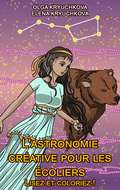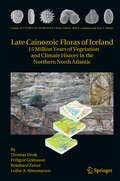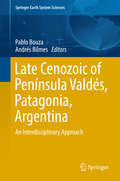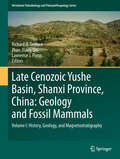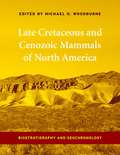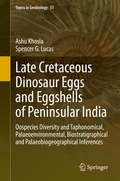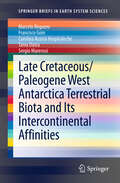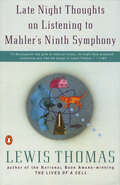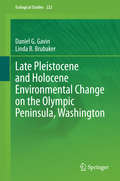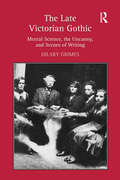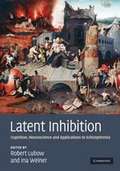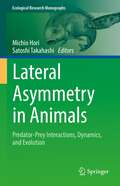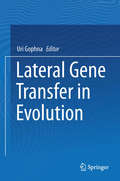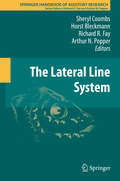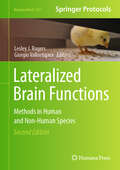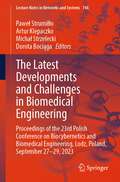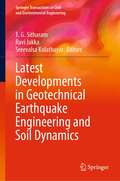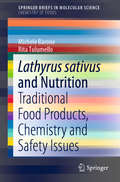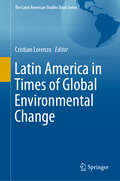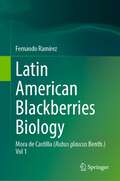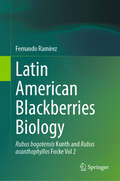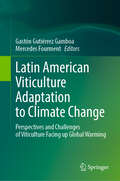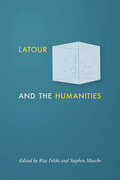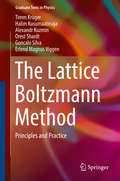- Table View
- List View
L'astronomie créative pour les écoliers. Lisez et coloriez !
by Olga Kryuchkova Elena KryuchkovaCe livre traite d'astronomie. Vous vous demandez ce qu'est l'astronomie ? L'astronomie est la science des objets cosmiques et des phénomènes célestes, l'étude de l'univers dans lequel nous vivons et de sa nature. Les astronomes font leurs recherches avec des télescopes dans d'immenses observatoires et avec des satellites en orbite autour de la terre. Les télescopes peuvent être lancés sur des fusées pour étudier la haute atmosphère et sur des aérostats non habités. Et certains véhicules et instruments peuvent même être lancés à bord de vaisseaux spatiaux pour explorer l'espace lointain. L'astronomie peut être professionnelle ou amateur. Les astronomes professionnels explorent le Soleil et le système solaire, la Voie lactée (où se trouve notre système solaire) et l'Univers en dehors de notre galaxie. Les astronomes professionnels forment également des étudiants dans l'enseignement supérieur et travaillent dans des observatoires. Les astronomes amateurs sont passionnés par l'astronomie en tant que passe-temps. Parfois, les astronomes amateurs peuvent se réunir dans des clubs où ils tiennent des réunions thématiques. Et ils observent différentes constellations, des éclipses solaires, etc. Dans ce livre, vous découvrirez notre planète Terre et son satellite, la Lune, d'autres planètes du système solaire et un certain nombre de constellations. Vous pourrez non seulement obtenir des informations utiles, accessibles et intéressantes, mais aussi colorier des illustrations en noir et blanc de l'image mythologique de telle ou telle planète, ou constellation. Ce livre est écrit dans un langage simple et accessible et s'adresse aux écoliers et collégiens. Il peut être utilisé comme matériel pédagogique supplémentaire dans le cadre scolaire.
Late Cainozoic Floras of Iceland
by Friðgeir Grimsson Leifur A. Símonarson Reinhard Zetter Thomas DenkBeing the only place in the northern North Atlantic yielding late Cainozoic terrestrial sediments rich in plant fossils, Iceland provides a unique archive for vegetation and climate development in this region. This book includes the complete plant fossil record from Iceland spanning the past 15 million years. Eleven sedimentary rock formations containing over 320 plant taxa are described. For each flora, palaeoecology and floristic affinities within the Northern Hemisphere are established. The exceptional fossil record allows a deeper understanding of the role of the "North Atlantic Land Bridge" for intercontinental plant migration and of the Gulf Stream-North Atlantic Current system for regional climatic evolution. 'Iceland sits as a "fossil trap" on one of the most interesting biogeographic exchange routes on the planet - the North Atlantic. The fossil floras of Iceland document both local vegetational response to global climate change, and more importantly, help to document the nature of biotic migration across the North Atlantic in the last 15 million years. In this state-of-the-art volume, the authors place sequential floras in their paleogeographic, paleoclimatic and geologic context, and extract a detailed history of biotic response to the dynamics of physical change.' Bruce H. Tiffney, University of California, Santa Barbara 'This beautifully-illustrated monograph of the macro- and microfloras from the late Cenozoic of Iceland is a worthy successor to Oswald Heer's "Flora fossilis arctica". Its broad scope makes it a must for all scientists interested in climatic change and palaeobiogeography in the North Atlantic region. It will remain a classic for years to come.' David K. Ferguson, University of Vienna
Late Cenozoic of Península Valdés, Patagonia, Argentina: An Interdisciplinary Approach (Springer Earth System Sciences)
by Pablo Bouza Andrés BilmesThis book presents extensive and new information on the Cenozoic marine and continental systems of one of the most important World Heritage sites of Southern South America: The Península Valdés. Using an interdisciplinary approach, that includes geological, biological and archeological perspectives of more than 30 specialists, an integrated description and analysis of the Cenozoic environments of the study region is presented. The volume brings together an update of the geology, climate, geomorphology, soils, biodiversity, archeology and human impact of the Península Valdés. The scope of this book extends to any natural science researcher of the world interested on the Cenozoic history of the Península Valdés.
Late Cenozoic Yushe Basin, Shanxi Province, China: Volume I:History, Geology, and Magnetostratigraphy
by Lawrence J Flynn Richard H Tedford Zhan-Xiang QiuThe Late Cenozoic Yushe Basin, Shanxi Province, China embodies the bulk of our knowledge on successions of terrestrial vertebrates in the northern part of East Asia. Everything we know about Asian mammals of the last 6 million years has a historical basis in the documentation of the geology of Yushe. This volume introduces the basin in its geological setting, describes the succession of fossiliferous strata, and shows how it is dated. It develops an unsurpassed level of precision for its age control. Geological maps and stratigraphic sections provide the backbone for individual studies to follow on varied fossil groups. The volume explores the history of exploration of the last century in Yushe Basin and places development of paleontology there into the context of the birth of the modern epoch of science in China.
Late Cretaceous and Cenozoic Mammals of North America: Biostratigraphy and Geochronology
by Michael WoodburneThis book places into modern context the information by which North American mammalian paleontologists recognize, divide, calibrate, and discuss intervals of mammalian evolution known as North American Land Mammal Ages. It incorporates new information on the systematic biology of the fossil record and utilizes the many recent advances in geochronologic methods and their results. The book describes the increasingly highly resolved stratigraphy into which all available temporally significant data and applications are integrated. Extensive temporal coverage includes the Lancian part of the Late Cretaceous, and geographical coverage includes information from Mexico, an integral part of the North American fauna, past and present.
Late Cretaceous Dinosaur Eggs and Eggshells of Peninsular India: Oospecies Diversity and Taphonomical, Palaeoenvironmental, Biostratigraphical and Palaeobiogeographical Inferences (Topics in Geobiology #51)
by Ashu Khosla Spencer G. LucasThis book documents analyses of the Late Cretaceous dinosaur nesting sites of the Lameta Formation at Jabalpur, Districts Dhar and Jhabua, Madhya Pradesh; Districts Kheda and Panchmahal (Gujarat); and the Pisdura, Dongargaon and Pavna sectors in the Chandrapur Districts of Maharashtra, which are exposed in India along an east-west and central axis. In this work, special emphasis has been given to the dinosaur nesting sites of the east-central Narbada River region, including its regional geology. The work was undertaken to provide detailed information concerning dinosaur eggs, eggshell fragments, nests and clutches found in the Lameta Formation of peninsular India. Prior to the present work there had been no detailed review of systematic work on the taxonomy, and of micro- and ultrastructural studies of dinosaur eggs and eggshells from the Lameta Formation. The study documents the field and laboratory investigations that facilitated the reconstruction of the morphotaxonomy, models for the burial pattern of eggs and eggshells, taphonomic implications,and the palaeoenvironmental context and palaeoecological conditions during the Late Cretaceous at the time of the extrusion of the Deccan traps, which may have been partly responsible for the extinction of the dinosaurs. The need to follow a parataxonomic classification for Indian dinosaur eggs and eggshell types is very apparent, and this book addresses this aspect in some detail. The emphasis on the application of parataxonomic schemes is based on the description of new oospecies and their comparison with previously known forms. The present work has led to the recovery of numerous nests, many collapsed eggs and hundreds of dinosaur eggshell fragments from the localities situated near the east, west and central Narbada River regions. It will be of interest to academics and professional palaeontologists, and all students of dinosaurs.
Late Cretaceous/Paleogene West Antarctica Terrestrial Biota and its Intercontinental Affinities
by Marcelo Reguero Francisco Goin Tania Dutra Sergio Marenssi Carolina Acosta HospitalecheOne of the most intriguing paleobiogeographical phenomena involving the origins and gradual sundering of Gondwana concerns the close similarities and, in most cases, inferred sister-group relationships of a number of terrestrial and freshwater vertebrate taxa, e.g., dinosaurs, flying birds, mammals, etc., recovered from uppermost Cretaceous/ Paleogene deposits of West Antarctica, South America, and NewZealand/Australia. For some twenty five extensive and productive investigations in the field of vertebrate paleontology has been carried out in latest Cretaceous and Paleogene deposits in the James Ross Basin, northeast of the Antarctic Peninsula (AP), West Antarctica, on the exposed sequences on James Ross, Vega, Seymour (=Marambio) and Snow Hill islands respectively. The available geological, geophysical and marine faunistic evidence indicates that the peninsular (AP) part of West Antarctica and the western part of the tip of South America (Magallanic Region, southern Chile) were positioned very close in the latest Cretaceous and early Paleogene favoring the "Overlapping" model of South America-Antarctic Peninsula paleogeographic reconstruction. Late Cretaceous deposits from Vega, James Ross, Seymour and Snow Hill islands have produced a discrete number of dinosaur taxa and a number of advanced birds together with four mosasaur and three plesiosaur taxa, and a few shark and teleostean taxa.
Late Night Thoughts on Listening to Mahler's Ninth Symphony
by Lewis ThomasThis magnificent collection of essays by scientist and National Book Award-winning writer Lewis Thomas remains startlingly relevant for today’s world. Luminous, witty, and provocative, the essays address such topics as “The Attic of the Brain,” “Falsity and Failure,” “Altruism,” and the effects the federal government’s virtual abandonment of support for basic scientific research will have on medicine and science.Profoundly and powerfully, Thomas questions the folly of nuclear weaponry, showing that the brainpower and money spent on this endeavor are needed much more urgently for the basic science we have abandoned—and that even medicine’s most advanced procedures would be useless or insufficient in the face of the smallest nuclear detonation. And in the title essay, he addresses himself with terrifying poignancy to the question of what it is like to be young in the nuclear age. “If Wordsworth had gone to medical school, he might have produced something very like the essays of Lewis Thomas.”—TIME “No one better exemplifies what modern medicine can be than Lewis Thomas.”—The New York Times Book Review
Late Pleistocene and Holocene Environmental Change on the Olympic Peninsula, Washington
by Daniel G. Gavin Linda B. BrubakerThis study brings together decades of research on the modern natural environment of Washington's Olympic Peninsula, reviews past research on paleoenvironmental change since the Late Pleistocene, and finally presents paleoecological records of changing forest composition and fire over the last 14,000 years. The focus of this study is on the authors' studies of five pollen records from the Olympic Peninsula. Maps and other data graphics are used extensively. Paleoecology can effectively address some of these challenges we face in understanding the biotic response to climate change and other agents of change in ecosystems. First, species responses to climate change are mediated by changing disturbance regimes. Second, biotic hotspots today suggest a long-term maintenance of diversity in an area, and researchers approach the maintenance of diversity from a wide range and angles (CITE). Mountain regions may maintain biodiversity through significant climate change in 'refugia': locations where components of diversity retreat to and expand from during periods of unfavorable climate (Keppel et al. , 2012). Paleoecological studies can describe the context for which biodiversity persisted through time climate refugia. Third, the paleoecological approach is especially suited for long-lived organisms. For example, a tree species that may typically reach reproductive sizes only after 50 years and remain fertile for 300 years, will experience only 30 to 200 generations since colonizing a location after Holocene warming about 11,000 years ago. Thus, by summarizing community change through multiple generations and natural disturbance events, paleoecological studies can examine the resilience of ecosystems to disturbances in the past, showing how many ecosystems recover quickly while others may not (Willis et al. , 2010).
Late Transition Metal-Carboryne Complexes
by Zaozao QiuZaozao Qiu shows in this thesis that transition metals can mediate or catalyze the cycloaddition or coupling reactions of carboryne with alkynes or alkenes to afford benzocarboranes, alkenylcarboranes or dihydrobenzocarboranes. These results represent powerful strategies to assemble useful complex molecules from very simple precursors in a single operation. Carboranes have many applications in medicine. However, their unique structures make derivatization difficult and the limited efficient synthetic methods to obtain functional carborane materials have restricted applications of carboranes within a narrow scope. This work breaks a new ground in metal-carboryne chemistry and will have a significant impact on synthetic, cluster and materials chemistry.
The Late Victorian Gothic: Mental Science, the Uncanny, and Scenes of Writing
by Hilary GrimesExamining the automatic writing of the spiritualist séances, discursive technologies like the telegraph and the photograph, various genres and late nineteenth-century mental science, this book shows the failure of writers' attempts to use technology as a way of translating the supernatural at the fin de siècle. Hilary Grimes shows that both new technology and explorations into the ghostly aspects of the mind made agency problematic. When notions of agency are suspended, Grimes argues, authorship itself becomes uncanny. Grimes's study is distinct in both recognizing and crossing strict boundaries to suggest that Gothic literature itself resists categorization, not only between literary periods, but also between genres. Treating a wide range of authors - Henry James, Rudyard Kipling, Arthur Conan Doyle, George Du Maurier, Vernon Lee, Mary Louisa Molesworth, Sarah Grand, and George Paston - Grimes shows how fin-de-siècle works negotiate themes associated with the Victorian and Modernist periods such as psychical research, mass marketing, and new technologies. With particular attention to texts that are not placed within the Gothic genre, but which nevertheless conceal Gothic themes, The Late Victorian Gothic demonstrates that the end of the nineteenth century produced a Gothicism specific to the period.
Latent Inhibition: Cognition, Neuroscience and Applications to Schizophrenia
by R. E. Lubow Ina WeinerLatent inhibition is a phenomenon by which exposure to an irrelevant stimulus impedes the acquisition or expression of conditioned associations with that stimulus. Latent inhibition, an integral part of the learning process, is observed in many species. This comprehensive collection of studies of latent inhibition, from a variety of disciplines including behavioural/cognitive psychology, neuroscience and genetics, focuses on abnormal latent inhibition effects in schizophrenic patients and schizotypal normals. Amongst other things, the book addresses questions such as, is latent inhibition an acquisition or performance deficit? What is the relationship of latent inhibition to habituation, extinction, and learned irrelevance? Does reduced latent inhibition predict creativity? What are the neural substrates, pharmacology, and genetics of latent inhibition? What do latent inhibition research and theories tell us about schizophrenia? This book provides a single point of reference for neuroscience researchers, graduate students, and professionals, such as psychologists and psychiatrist
Lateral Asymmetry in Animals: Predator-Prey Interactions, Dynamics, and Evolution (Ecological Research Monographs)
by Michio Hori Satoshi TakahashiThis book presents the latest research findings on the laterality of fish and other animals. It describes all aspects of lateral asymmetry, including ecology, morphology, behaviour, dynamics of lefty and righty morphs, genetics and evolution, through field observations, experiments and modeling. Lateral asymmetry in scale-eating cichlids gives a simple and beautiful example of negative frequency-dependent selection and resulting oscillation of lefty and righty morph frequencies. Lateral dimorphism is found not only in scale-eaters but in all orders of fish, shrimps and cuttlefish. Lateral asymmetry interacts between species through "cross-predation." Contrary to fish, lateral asymmetry in snails acts as, in most cases, positive frequency-dependent selection and provides deep insights into speciation. Especially, snakes eating righty snails facilitate speciation of lefty snails.As a collaboration work of field ecologists and theoretical biologists, this book covers a variety of topics on lateral asymmetry, which are consistently related to predation. The topics include behavioral ecology, population dynamics, physiology, evolution, genetics, development, learning and neuroscience, statistics, with the subjects of fish, shrimp, prawn, and crayfish, crab, cuttlefish, and snake and snail. Chapters cover new research results such as cuttlefish laterality dynamics, interaction between laterality of snails and snakes, evolution of laterality genetic system, and statistical analysis of laterality oscillation. Readers will appreciate the simplicity and beauty of lateral asymmetry and its profound impact on ecology and evolution.
Lateral Gene Transfer in Evolution
by Uri GophnaAlthough the phenomenon of lateral gene transfer has been known since the 1940's, it was the genomics era that has really revealed the extent and many facets of this evolutionary/genetic phenomenon. Even in the early 2000s with but a handful of genomes available it became clear that the nature of microorganisms is full of genetic exchange between lineages that are sometimes far apart. The years following this saw an explosion of genomic data, which shook the 'tree of life' and also raised doubts about the most appropriate species concepts for prokaryotes. This book attempts to represent the many-fold contributions of LGT to the evolution of micro and, to an extent, macro-organisms by focusing on the areas where the Editor felt it had the largest impact: metabolic innovations and adaptations and speciation.
The Lateral Line System
by Sheryl Coombs Horst Bleckmann Richard R. Fay Arthur N. PopperThe Lateral Line System provides an overview of the key concepts and issues surrounding the development, evolution, neurobiology, and function of the lateral line, a fascinating yet somewhat enigmatic flow-sensing system. The book examines the historical precedence for linking the auditory and lateral line systems, its structure and development, use of the lateral line system of zebrafish as a model system, physical principles governing the response properties of the lateral line, the behavioral relevance of this sensory system to the lives of fish, and an examination of how this information is shaped and encoded by the peripheral and central nervous systems. Contents The Gems of the Past: A Brief History of Lateral Line Research in the Context of the Hearing Sciences - Sheryl Coombs and Horst Bleckmann Morphological Diversity, Development, and Evolution of the Mechanosensory Lateral Line System - Jacqueline F. Webb The Hydrodynamic of Flow Stimuli - Matthew J. McHenry and James C. Liao The Biophysics of the Fish Lateral Line - Sietse M. van Netten and Matthew J. McHenry Sensory Ecology and Neuroethology of the Lateral Line - John Montgomery, Horst Bleckmann, and Sheryl Coombs Information Encoding and Processing by the Peripheral Lateral Line System - Boris Philippe Chagnaud and Sheryl Coombs The Central Nervous Organization of the Lateral Line System - Mario F. Wullimann and Benedikt Grothe Central Processing of Lateral Line Information - Horst Bleckmann and Joachim Mogdans Functional Overlap and Nonoverlap Between Lateral Line and Auditory Systems - Christopher B. Braun and Olav Sand The Hearing Loss, Protection, and Regeneration in the Larval Zebrafish Lateral Line - Allison B. Coffin, Heather Brignull, David W. Raible, and Edwin W Rubel
Lateralized Brain Functions: Methods in Human and Non-Human Species (Neuromethods #217)
by Lesley J. Rogers Giorgio VallortigaraThis second edition volume expands on the previous edition with updates on the latest techniques used to study brain and behavioral laterality in both human and non-human animals. The chapters in this book cover numerous topics such as methods of measuring lateralization in a range of species by scoring behavior elicited by inputs to one of both brain hemispheres; behavioral methods to study motor preferences and lateralization in invertebrates; neurological methods to reveal lateralization; imaging and electrocephalographic techniques and transcranial stimulation; and new genetic approaches to studying lateralization in humans and zebrafish, and the roles of genes in the establishment and development of brain asymmetry. In the Neuromethods series style, chapters include the kind of detail and key advice from the specialists needed to get successful results in your laboratory. Cutting-edge and authoritative, Lateralized Brain Function: Methods in Human and Non-Human Species, Second Edition is a valuable resource for further research on brain and behavioral asymmetries in human and non-human species. This book will provide both expert and novel researchers with answers to their questions, while also encouraging vital collaborations.
The Latest Developments and Challenges in Biomedical Engineering: Proceedings of the 23rd Polish Conference on Biocybernetics and Biomedical Engineering, Lodz, Poland, September 27–29, 2023 (Lecture Notes in Networks and Systems #746)
by Paweł Strumiłło Artur Klepaczko Michał Strzelecki Dorota BociągaThe book contains 35 chapters, in which you can find various examples of the development of methods and/or systems supporting medical diagnostics and therapy, related to biomedical imaging, signal and image processing, biomaterials and artificial organs, modelling of biomedical systems, which were presented as current research topics at the 23rd Polish Biocybernetics and Biomedical Engineering Conference, held at the Institute of Electronics, Lodz University of Technology in September 2023. The ongoing and dynamic development of AI-based data processing and analysis methods plays an increasingly important role in medicine. This book addresses these issues by presenting applications of such methods in various areas, such as disease diagnosis and prediction, particularly through the use of image data analysis algorithms. Other topics covered include personalized medicine, where multimodal patient data is acquired and analyzed, as well as robotic surgery and clinical decision support.The book is of interest to an advanced and broad readership, including researchers and engineers representing both medical, biological, and engineering viewpoints. Its readers may also be graduate and postgraduate students in various fields such as biomedical engineering, artificial intelligence, biomaterials, and medical electronics, as well as software developers in R&D departments working in the field of intelligent healthcare engineering.
Latest Developments in Geotechnical Earthquake Engineering and Soil Dynamics (Springer Transactions in Civil and Environmental Engineering)
by T. G. Sitharam Ravi Jakka Sreevalsa KolathayarThis volume brings together contributions from world renowned researchers and practitioners in the field of geotechnical engineering. The chapters of this book are based on the keynote and invited lectures delivered at the 7th International Conference on Recent Advances in Geotechnical Earthquake Engineering and Soil Dynamics. The book presents advances in the field of soil dynamics and geotechnical earthquake engineering. A strong emphasis is placed on proving connections between academic research and field practice, with many examples, case studies, best practices, and discussions on performance-based design. This volume will be of interest to research scholars, academicians and industry professionals alike.
Lathyrus sativus and Nutrition: Traditional Food Products, Chemistry and Safety Issues (SpringerBriefs in Molecular Science)
by Michele Barone Rita TulumelloThis book addresses the traditional use of a specific crop legume, grass pea (Lathyrus sativus), as a food product and ingredient for typical food products. Grass pea has very interesting nutritional qualities, including an abundance of proteins and peculiar organoleptic properties. As the crop also shows an enhanced resistance to adverse conditions, it is used in many geographical areas as the main ingredient of certain traditional foods. On the other hand, grass pea is questionable as a source of human and animal nutrition because it contains a neurotoxin – β-N-oxalyl-L-α,β-diaminopropionic acid – that is known for its neurological effects. The related disease is referred to as ‘neurolathyrism’ and occurs when grass pea-based foods are consumed in large quantities. The book is divided into five chapters, the first of which summarizes the chemical and biochemical properties of grass pea and provides nutritional evaluations. The second chapter provides an overview of foods containing Lathyrus sativus around the world, while the third describes Italian foods in detail. The fourth chapter focuses on the problem of neurolathyrism in connection with human nutrition and health. In closing, the fifth chapter sheds light on the historical and traditional food products sector from a food traceability and authenticity standpoint.
Latin America in Times of Global Environmental Change (The Latin American Studies Book Series)
by Cristian LorenzoThis volume discusses the challenges of Latin America in global environmental geopolitics. Written by leading experts, this book brings together Latin American research on global environmental change. They cover a range of topics such as climate change, water, forest and biodiversity conservation connected with science policies, public opinion, priorities of international funds, and international politics of Latin American countries. The book describes the discrepancy between the international priorities and the regional needs or country interests. It includes several case studies and analyses the cooperation in multilateral negotiations on climate change. It also offers a synthesis of debates around global environmental changes and Latin American politics, which the authors have previously promoted in different academic events in South America, including in Santiago de Chile in Chile, and Buenos Aires and Ushuaia in Argentina.This book assesses the environmental problems from different perspectives, highlights the scientific development in the environmental changes affecting Latin America and offers a new view on geopolitics to help face those issues. Specialist readers in international relations, political sciences, environmental sciences, geography and geopolitics will appreciate this up-to-date examination of Latin America and the global environmental change.
Latin American Blackberries Biology: Mora de Castilla (Rubus glaucus Benth.) Vol 1
by Fernando RamírezThe current book focuses on Mora de Castilla (Rubus glaucus Benth.). It explores aspects, such as origin, phenology, propagation, floral and fruit morphology, arthropod visitors, pollination mechanisms, propagation methods, chromosome number, fruit development, breeding, morphological diversity, and the impact of climate change. It includes novel data about plant phenology, flowering, insect visitors, seed germination, fruit morphology, and allometric relationships. This work includes an in-depth review of the most recently published information on the topic. Mora de Castilla is an economically important fruit crop from the Andes. It has been crossed with other Rubus species due to its high yield and everbearing habit. Currently, it is an economically important plant. It has been hybridized with other Rubus species producing new and better-quality hybrids This book contains numerous photographs selected by the author to provide the reader with detailed information about the plant´s morphological features and arthropod visitors.
Latin American Blackberries Biology: Rubus bogotensis Kunth and Rubus acanthophyllos Focke Vol 2
by Fernando RamírezThis book explores two Rubus species from South America. It will address the species Rubus bogotensis Kunth and Rubus acanthophyllos Focke. It addresses aspects, such as origin, phenology, propagation, floral and fruit morphology, arthropod visitors, pollination, breeding, morphological diversity, and genetic diversity. It includes new unpublished data and results about plant phenology, flowering, insect visitors, fruit length-weight relationships, and fruit and pyrene morphology. This work includes an in-depth review of the most recently published information on the topic. The Rubus species studies are underutilized crops from Latin America. Furthermore, these species could be used in breeding programs for improvement. They can also be hybridized with other Rubus species to obtain better-quality hybrids. This book contains numerous photographs selected by the author to provide the reader with detailed information about the plant´s morphological features and arthropod visitors.
Latin American Viticulture Adaptation to Climate Change: Perspectives and Challenges of Viticulture Facing up Global Warming
by Gastón Gutiérrez Gamboa Mercedes FourmentLatin American viticulture faces a wide range of difficulties that include social, political, economic, and productive aspects. Soil diversity, together with the climates in which the viticulture activity takes place, favours the production of grapes, juices, raisins, musts, wines, and distillates with unique and distinctive characters for the world. In addition, the great genetic diversity that covers autochthonous and minor grapevine varieties, including unknown genotypes, opens a wide range of research opportunities for the adaptation of the viticulture to the negative effects of global warming, favouring sustainability and social equity. This book compiles the research about the new viticultural trends performed in diverse regions from Latin America such as Argentina, Brazil, Bolivia, Chile, Dominican Republic, Haiti and Uruguay, covering different topics in viticulture of global importance. This book addresses the impacts of soil and climatic conditions and viticultural practices on vine physiology, berry quality and wine typicity, including topics related to social sciences and agricultural economics. This will allow to provide a relevant discussion for future guidelines in viticulture under a territorial development perspective.
Latour and the Humanities
by Rita Felski and Stephen MueckeHow does the work of influential theorist Bruno Latour offer a fresh angle on the practices and purposes of the humanities?In recent years, defenses of the humanities have tended to argue along predictable lines: the humanities foster empathy, the humanities encourage critical thinking, the humanities offer a counterweight to the cold calculations of the natural and social sciences. The essays in Latour and the Humanities take a different approach. Exploring the relevance of theorist Bruno Latour's work, they argue for attachments and entanglements between the humanities and the sciences while looking closely at the interests, institutions, and intellectual projects that shape the humanities within and beyond the university. The collection, which is written by a group of highly distinguished scholars from around the world, is divided into two sections. In the first part, authors engage in depth with Latour's work while also rethinking the ties between the humanities and the sciences. Essays argue for greater attention to the nonhuman world, the urgency of climate change, and more nuanced views of universities as institutions. The second half of the volume contains essays that reflect on Latour's influence on the practices of specific disciplines, including art, the digital humanities, film studies, and political theory.Inspiring conversation about the relevance of actor-network-theory for research and teaching in the humanities, Latour and the Humanities offers a substantial introduction to Latour's work while discussing the humanities without falling back on the genres of either the sermon or the jeremiad. This volume will be of interest to all those searching for fresh perspectives on the value and importance of humanistic disciplines and thought.Contributors: David J. Alworth, Anders Blok, Claudia Breger, Dipesh Chakrabarty, Yves Citton, Steven Connor, Gerard de Vries, Simon During, Rita Felski, Francis Halsall, Graham Harman, Antoine Hennion, Casper Bruun Jensen, Bruno Latour, Heather Love, Patrice Maniglier, Stephen Muecke, Barbara Herrnstein Smith, Nigel Thrift, Michael Witmore
The Lattice Boltzmann Method
by Timm Krüger Halim Kusumaatmaja Alexandr Kuzmin Orest Shardt Goncalo Silva Erlend Magnus ViggenThis book is an introduction to the theory, practice, and implementation of the Lattice Boltzmann (LB) method, a powerful computational fluid dynamics method that is steadily gaining attention due to its simplicity, scalability, extensibility, and simple handling of complex geometries. The book contains chapters on the method's background, fundamental theory, advanced extensions, and implementation. To aid beginners, the most essential paragraphs in each chapter are highlighted, and the introductory chapters on various LB topics are front-loaded with special "in a nutshell" sections that condense the chapter's most important practical results. Together, these sections can be used to quickly get up and running with the method. Exercises are integrated throughout the text, and frequently asked questions about the method are dealt with in a special section at the beginning. In the book itself and through its web page, readers can find example codes showing how the LB method can be implemented efficiently on a variety of hardware platforms, including multi-core processors, clusters, and graphics processing units. Students and scientists learning and using the LB method will appreciate the wealth of clearly presented and structured information in this volume.
